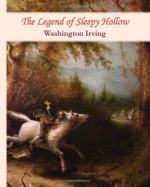|
This section contains 3,260 words (approx. 11 pages at 300 words per page) |

|
SOURCE: “Post Mortem Effects,” in Comedy and America: The Lost World of Washington Irving, Kennikat Press, 1976, pp. 155-69.
In the following excerpt, Roth examines the conflict between “the active and the imaginative life” in “The Legend of Sleepy Hollow.”
“The Legend of Sleepy Hollow” is Irving's last attempt to preserve a festive America. Like The History and “Rip Van Winkle,” it is a tale of a Yankee invasion, but in it the Yankee is temporarily defeated, and his defeat is due primarily to the Yankee-American inability to assign any value to the world of dreams and imaginings. There is a hint of this theme toward the end of “Rip Van Winkle”: the villagers who doubt the reality of Rip's tale and insist “that Rip had been out of his head, and that this was one point on which he always remained flighty” (Washington Irving: Representative Selections, 1934; Hereafter RS...
|
This section contains 3,260 words (approx. 11 pages at 300 words per page) |

|


